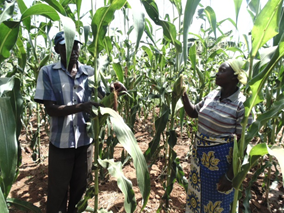
April 2017—As Mutua Kaite walks along the terraces of his 4-acre farm in southeastern Kenya, he points to the bounty of growing crops. Five years ago, the land was dry and Kaite’s crops suffered.
Today, Kaite harvests tomatoes, kale, spinach and sweet potatoes in abundance, and has begun growing drought-tolerant crop varieties of millet, black beans, sorghum and cassava. He has grown up to five times as many beans on his land and he has quadrupled his livestock.
Kaite attributes his success to what he learned in school.
In 2013, the U.N. World Food Program (WFP), a USAID partner, established the Kathitu Farmer Field School in Mwingi town, Kitui County, near Kaite’s home. At the school, farmers learn to build soil and water conservation structures that they can replicate at home. Kaite and 21 other students worked jointly with facilitators to learn how to improve food production. While they are students, farmers receive payments in exchange for their work on the 2-acre school farm.
Armed with new knowledge, Kaite got to work on his own land, which is hilly and prone to erosion and surface runoff. He built terraces and small water catchments, and planted indigenous trees to help retain water. Kaite has not only expanded the variety and quantity of crops he grows, but he also harvests honey and sells chickens.
To increase crop production further, Kaite wanted to invest in more infrastructure but needed additional funds. Luckily, students of the farmer field school formed a village savings and loan group so members can access financial services. With a small loan from the group, Kaite was able to purchase a large water tank and irrigation pipes to further improve his farm.
Kaite is thrilled that his training has helped him create a farm that can provide for his family and is now happily giving back to his community by training others on pest control, soil and water conservation, and manure application.
Prior to attending the field school, Kaite says, “I was very poor and food insecure. But now as I graduate from the program, I want to encourage others to save the compensation they receive and do something that they will remember long after the project has been completed.”
Through 161 USAID-supported farmer field schools in Kenya, farmers like Kaite are increasing their production, diversifying their sources of income, and becoming self-reliant. Across five counties in the southeastern region, where semi-arid conditions make it difficult to grow crops, 94,000 people can now meet their food needs even during the lean season. These farmers are building farms and livelihoods that are resilient, ensuring food security lasts.
With USAID support, WFP is reaching more than 1.2 million people in Kenya’s northern drylands and southeastern marginal agricultural areas with cash-based transfers and in-kind food assistance in exchange for work building or rehabilitating community assets, such as local roads or irrigation systems. Kenya’s 2016 rainy seasons were deficient, but the efforts of USAID, WFP and other partners are helping Kenyans withstand the current drought and continue to build resilience to future shocks.
Since October 2015, USAID has provided more than $106 million in food assistance to provide relief and build resilience among the most vulnerable and chronically food insecure populations in Kenya.
LINKS







Comment
Make a general inquiry or suggest an improvement.